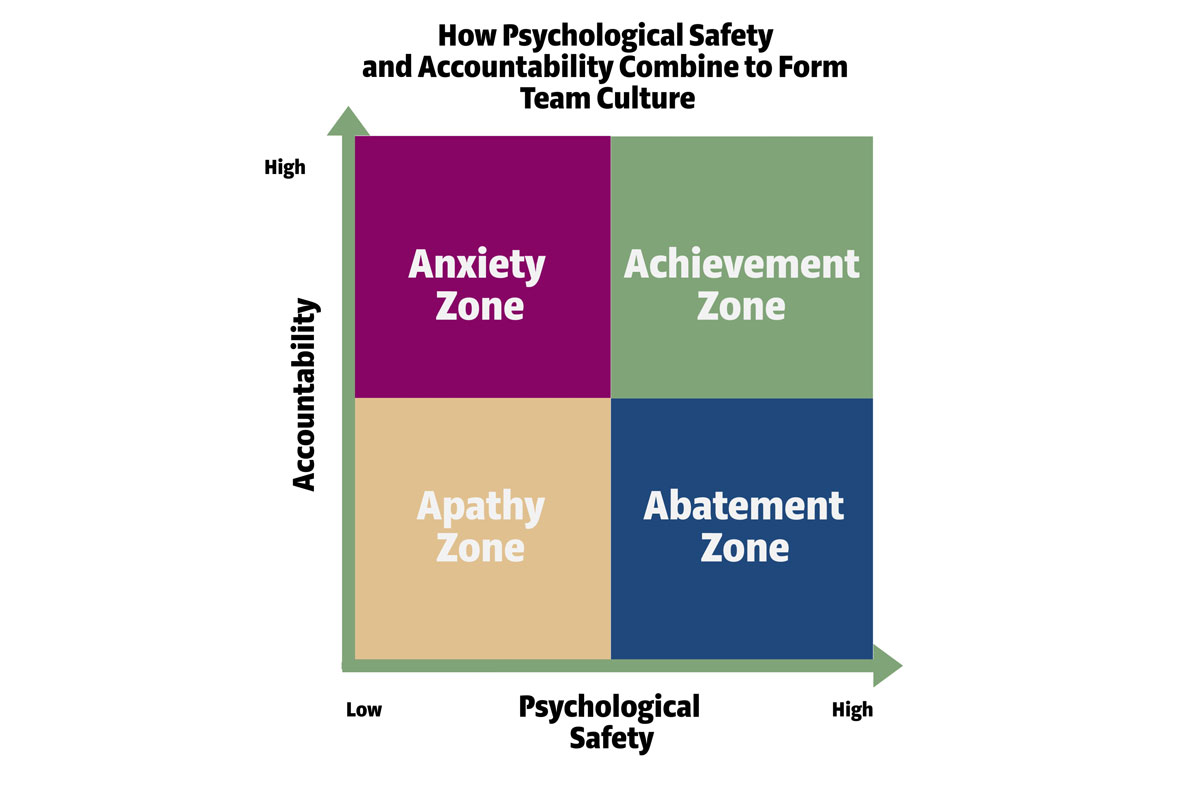One of the challenges leaders face is finding a balance between fostering a friendly, warm environment versus putting pressure on their employees to improve work quality and meet deadlines.
In a highly popular TEDx video, Amy Edmondson, a Harvard Business professor, talks through her research on the impact of accountability and psychological safety in teams. She discovered that when high levels of psychological safety and accountability collide it leads to high performance.
Her theory has been the genesis for my Achievement Zone Model (below). It consists of four zones of team performance based on work I have done with teams over the years. The good news is that these four team zones are not fixed. Teams move in and out of them, as does the leader themselves and each of their team members.

Essentially, both psychological safety and accountability are modelled and managed by the team leader. How a leader models and rewards behaviour creates the culture in which a team operates.
Let’s delve into them in more detail.
Apathy Zone
When leaders create low psychological safety and low accountability, you will often find that employees are in conflict. This can be one of the riskiest teams to work in which results in employees not working too hard because their energy is spent on self-preservation.
Employees are afraid of doing the wrong thing or feel exhausted and burnt out. This can be from the result of authoritative, emotionally volatile leaders that are closed off to their direct reports and who unwittingly create a psychologically unsafe team culture. Leaders who have lots of projects going on and who tend to under manage their team also can accidentally create teams in apathy. This zone is incredibly low in trust and team cohesion.
Abatement Zone
In this zone, leaders are often uncomfortable improving themselves and subsequently pulling people up for poor performance. This comfortable and mind-numbingly boring (but happy) place is when leaders create psychological safety, but don’t hold their employees accountable for excellence. This is the confusing employee engagement result that points to high employee engagement in a team, despite poor productivity (and other teams totally frustrated with their lack of performance).
In this environment, employees have no incentive to stretch themselves, be proactive or creative. Performance here is abating. Employees believe they are doing a good job but have no desire to improve or even think differently.
Usually leaders in this zone are the ones stressed out, as team members will escalate problems to their boss to solve, only work 9–5pm and lack the motivation to move beyond their task list. It would seem that working in a comfort zone is a great place. But it’s where ideas go to die, people coast, problems don’t get solved and where groupthink reigns supreme.
Interestingly, trust is also low in this team because team members can’t rely on each other to do a good job (but tend to not get upset by it, unless they are young or ambitious).
Anxiety Zone
Teams in this zone are high-performing and can often be admired throughout an organisation for their work ethic and focus on results. But they are psychologically damaging environments as the focus is on outputs, rather than people.
Employees are worked hard, criticised profusely and have little support from their leader or teammates. Typically, it’s a competitive environment where staff are pitted against each other due to the false belief that this will make them do better work. Stress and burnout are major issues in this zone.
This zone is common in high pressure environments such as IT, legal, finance and medical. Interestingly, some purpose-driven organisations can often be found here because they reward behaviours that are aligned to the purpose. However, they often confuse rewarding achieving purposeful outcomes as being a success indicator, rather than the right behaviours to achieve them. Meaning that toxic behaviours can run rampant as they run under the guise of purpose, therefore masking the real impact to staff wellbeing.
Achievement Zone
This occurs when a team leader creates stretch goals and challenges direct reports to improve and strongly believes they can achieve. A lot of leaders approve small incremental improvements to goals. But a leader in this zone treats employees like athletes pushing them to continually improve – breaking their best records, not by a few degrees but through dramatic improvement.
Employees work in a supportive environment where they work together to break their records every day. This only works when the leader leads by example, works hard to ensure they are trusted by the team and encourages team members to trust one another.
Reaching and staying in the Achievement Zone
So how do you balance both psychological safety and accountability?
If we want to lead our teams into the Achievement Zone, we need to lead ourselves there first. In my research, I have found four things that Achievement Zone leaders work on:
Spend time self-reflecting on their behaviours – Understanding how we are
getting results ensures we stay in the Achievement Zone. A lot of leaders reflect on what they have achieved, but reflecting on how we achieve results is key to ensuring the
right behaviours and team environment. Essentially, your line of enquiry is:
- What am I trying to do here?
- How can I best support others to do their best work?
- How did I increase/decrease safety or connection this week?
Get Curious – Neuroscientists have discovered that being curious lights up the reward network of our brain. Learning new things makes us feel safe.
Scheduling unfocused free time to allow yourself to do or think about what you want to is a powerful technique to get you into the Achievement Zone. Make time to call other people and ask about what changes they are seeing in their world. You can even just get playful asking yourself “What if?” or “Why not?” questions. Questions such as “What if we did it this way?” or “What would happen if we reduced the time of our team meetings?” can be a great starting point.
Envision a Positive Future – Remember when you were a kid and you used to daydream?
Schedule time during your week to envision your future. When you wake up, spend three minutes each morning (while you are still in bed) living a day in your ideal future. See yourself wearing clothes you love, doing work you love and having enjoyable interactions with your peers and direct reports.
Continuous improvement – Leaders who are in the Achievement Zone are always looking to improve what they do. They are never happy with the status quo and they learn from both success and failure. This means they are open to accepting feedback from others and don’t get defensive. Instead, they take feedback and do what they can to improve, if the feedback is valid. One technique that I teach leaders during coaching is SKS. Ask your direct reports, peers and boss:
- What should I stop doing?
- What should I keep doing?
- What should I start doing?
Achievement Zone leaders are always working on improving themselves and acting as a role model for others. It takes time and lots of self-reflection, but the results are worth it.
Marie-Claire Ross a speaker, trainer and coach at Trustologie who helps leaders and organisations improve trust in teams. You can find out more about the Achievement Zone in her new book Trusted To Thrive: How Leaders Create Connected and Accountable Teams.







